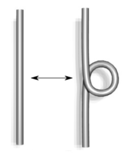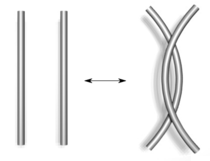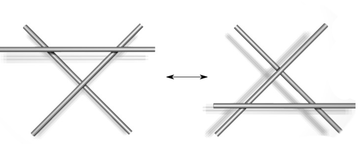User:Jkasd/Reidemeister move
| This is a Wikipedia user page. This is not an encyclopedia article or the talk page for an encyclopedia article. If you find this page on any site other than Wikipedia, you are viewing a mirror site. Be aware that the page may be outdated and that the user in whose space this page is located may have no personal affiliation with any site other than Wikipedia. The original page is located at https://en.wikipedia.org/wiki/User:Jkasd/Reidemeister_move. |
In the mathematical area of knot theory, a Reidemeister move refers to one of three local moves on a link diagram. In 1927, J.W. Alexander and G.B. Briggs, and independently Kurt Reidemeister, demonstrated that two knot diagrams belonging to the same knot, up to planar isotopy, can be related by a sequence of the three Reidemeister moves.
 |

|
| Type I | Type II |

| |
| Type III | |
The Reidemeister moves
[edit]Each move operates on a small region of the diagram and is one of three types:
- Twist and untwist in either direction.
- Move one loop completely over another.
- Move a string completely over or under a crossing.
Sometimes planar isotopy is treated as a 0th Reidemeister move. The numbering for the types of moves corresponds to how many strands are involved, e.g. a type II move operates on two strands of the diagram.
Proof that the Reidemeister moves are sufficient
[edit]Reidemeister considered point and line representations of knots.
The Reidemeister moves and knot invariants
[edit]One important context in which the Reidemeister moves appear is in defining knot invariants. By demonstrating a property of a knot diagram which is not changed when we apply any of the Reidemeister moves, an invariant is defined. Many important invariants can be defined in this way, including the Jones polynomial.
The type I move is the only move that affects the writhe of the link. The type III move is the only one which does not change the crossing number of the diagram.
Bruce Trace showed that two knot diagrams are related by using only type II and III moves if and only if they have the same writhe and winding number. Furthermore, combined work of O. Östlund, V. O. Manturov, and T. Hagge shows that for every knot type there are a pair of knot diagrams so that every sequence of Reidemeister moves taking one to the other must use all three types of moves. Alexander Coward demonstrated that for link diagrams representing equivalent links, there is a sequence of moves ordered by type: first type I moves, then type II moves, type III, and then type II. The moves before the type 3 moves increase crossing number while those after decrease crossing number.
The Reidemeister moves and the unknotting problem
[edit]In another vein, Stefano Galatolo, and independently Joel Hass and Jeffrey Lagarias (with a better bound), have shown that there is an upper bound (depending on crossing number) on the number of Reidemeister moves required to change a diagram of the unknot to the standard unknot. This gives an inefficient algorithm to solve the unknotting problem.
Chuichiro Hayashi proved there is also an upper bound, depending on crossing number, on the number of Reidemeister moves required to split a link.
References
[edit]- J. W. Alexander; G. B. Briggs, On types of knotted curves. Ann. of Math. (2) 28 (1926/27), no. 1-4, 562--586.
- Kurt Reidemeister, Elementare Begründung der Knotentheorie, Abh. Math. Sem. Univ. Hamburg 5 (1926), 24-32
- Bruce Trace, On the Reidemeister moves of a classical knot. Proc. Amer. Math. Soc. 89 (1983), no. 4, 722--724.
- Tobias Hagge, Every Reidemeister move is needed for each knot type. Proc. Amer. Math. Soc. 134 (2006), no. 1, 295--301.
- Stefano Galatolo, On a problem in effective knot theory. Atti Accad. Naz. Lincei Cl. Sci. Fis. Mat. Natur. Rend. Lincei (9) Mat. Appl. 9 (1998), no. 4, 299--306 (1999).
- Joel Hass; Jeffrey Lagarias, The number of Reidemeister moves needed for unknotting. J. Amer. Math. Soc. 14 (2001), no. 2, 399--428
- Chuichiro Hayashi, The number of Reidemeister moves for splitting a link. Math. Ann. 332 (2005), no. 2, 239--252.
